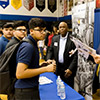Putting Military Veterans’ Skills to Work
Programs to hire military veterans, who have acquired problem-solving and leadership skills during their service, as well as programs to hire their spouses, are expanding.
Workforce Q4 2017

When the U.S. Chamber of Commerce Foundation started its Hiring Our Heroes (HOH) program in 2011, unemployment was still high nationwide in the wake of the Great Recession, and especially high for military veterans and their families. By June of 2015, the program had reached its goal of hiring 500,000 military veterans and spouses. In five years, because of HOH and other programs, the unemployment rate for veterans has dropped to an all-time low. The post-recession, 30 percent unemployment among vets is now 10 to 15 percent, according to Eric Eversole, a U.S. Chamber of Commerce vice president and president of HOH.
Last November, program officials conducted a study that showed a need for job-finding assistance to “transitioning” service members who are leaving the military. “We saw that we still have a large number of service members who are spending more than four months finding their first job,” Eversole says. Accordingly, HOH has shifted to a “more strategic approach,” Eversole explains, focusing on the approximately 200,000 service members who leave the military each year. One HOH initiative is a corporate fellowship program to pair active-duty service members with companies for 12 weeks, just before their discharge. More than 700 vet fellows have participated, with 82 percent being placed in jobs for an average wage of $70,000, notes Eversole. Major manufacturers such as General Motors, Toyota, and Lockheed Martin are involved, to recruit workers equipped to succeed in advanced manufacturing.
Additionally, as HOH developed, a suite of online tools was added to help military job seekers worldwide on a 24/7 basis. Two of these tools, the Personal Branding Resume Engine for veterans and Career Spark for spouses (both powered by Toyota), are digital programs built to help job seekers translate their military background and skills into resume language that hiring managers and HR representatives understand.
Going forward, the HOH program will continue to emphasize on-base events and also focus on helping military spouses find suitable employment, Eversole says. Military spouses still face 16 percent unemployment, four times the national average. A number of military personnel have been leaving the service due to lack of career opportunities for their spouses. Eversole says one of the program objectives is to “help the military retain the best and brightest.”
“Military families want and need two incomes, so we are trying to change the narrative,” Eversole says. In 2018, HOH plans to do 35 events targeted at spouses at military installations. “We’re working with companies to identify opportunities for spouses,” he says, citing Nestle Co. as one example. “Many military spouses are incredibly well educated. But that population is being under-utilized, because we need to think differently about them, as a tremendously valuable subset.”
Training Efforts
In 2012, the Washington, D.C.-based Manufacturing Institute partnered with four of the largest U.S. manufacturers to launch Get Skills to Work, one of the biggest efforts to train veterans for manufacturing careers. More than 500 companies have been involved, along with about 50 community colleges.
In January, the Institute is starting a new training program called Heroes Make America. The 10-week program will give transitioning service members training in basic manufacturing skills and certification, before they are discharged. It will be offered first at Fort Riley, Kan., and then rolled out to more locations, according to Carolyn Lee, executive director of the Manufacturing Institute. The program will make it easier to get vets into the employment pipeline, Lee says. Caterpillar and Hallmark are two of the 10 companies engaged (so far) to provide jobs for vets from Fort Riley. A technical college will provide skill training, and vets will also be able to access help with “soft” skills such as resume preparation and interviewing. “We also want to add to that support in the community, including other people who have made the transition, to help them adjust and succeed,” Lee says.
Military spouses still face 16 percent unemployment, four times the national average. One company that has focused on recently or soon-to-be discharged veterans to find well-qualified employees is Denver-based DaVita Kidney Care, which operates about 2,500 kidney dialysis clinics nationwide. Since 2010, DaVita has hired more than 3,000 veterans. According to Andy Crish, a division vice president with DaVita and a U.S. Naval Academy graduate who served six years in the U.S. Navy, leaving at the end of 2006, the company “has always looked at hiring vets as the right thing to do because of the skills they bring and some of they success they’ve had here since the company started.” Within the last five years, the company has ramped up its vets program, adding a dedicated military recruiter.
DaVita does a lot of recruiting at veteran-specific military job fairs, and has a national hiring day, and goes to college business schools to meet with veterans associations. In September, DaVita hosted a first-of-its kind National Veteran Interview Day at eight of its locations across the U.S. Vets also had the chance to interview by phone.
To augment its vet training program, DaVita just started a new, two-day class called Veterans 2 Village (V2V) that focuses on self-development and introduces new veteran teammates to DaVita’s existing military programs and benefits. Veteran Guides help facilitate the V2V live course. “We also have less formal vet mentoring,” Crish says. “Anytime a veteran employee is struggling with something, they can talk to a fellow veteran” through a vets work group led by the company’s military recruiter.
Crish has some advice for companies that would like to hire veterans: “First, really invest in understanding veterans’ skill sets. Also, you need to have a good training program to cover business skills and acumen.” Finally, once they are hired, “honor and support them.”
A Clear Business Case
Lida Citroen, author of the book Engaging With Veteran Talent, says, “The business case for hiring veterans is clear. This is an exceptional work force, with integrity and commitment to serve. Someone who has been in the military will have had opportunities to learn things many civilians have not — things like problem solving and leadership. They are taught that when there is an obstacle or problem, you don’t stop to find out whose job it is to fix it. You fix it,” she explains.
Citroen says the first step for companies that would like to hire veterans is finding out “if you have any veterans in the company right now. If they are willing, bring them into the conversation, to involve your target audience. Figure out your objectives and what success looks like” for vet hires.
It’s also important to train the hiring team to understand military resumes, which “look a little different” from standard business resumes.
When interviewing veterans, remember, “there are certain questions that are legal to ask, but not very kind,” Citroen says. “For example, you can’t ask someone if they have PTSD, but you can ask, ‘Is there anything that would make it difficult for you to do your job?’ So, it’s good to do a little HR training around that,” she advises.
“Hiring veterans doesn’t need to be difficult or expensive,” Citroen notes. “To get started, talk to other organizations in your community that work with vets. Start learning about this community that looks just like you and I, and are working all around us.”
Project Announcements
Australia-Based Aquatic Leisure Technologies Group Plans Opp, Alabama, Manufacturing Operations
12/11/2025
Teradyne Plans Wixom, Michigan, Robotics Operations
12/11/2025
Robinson Plans Altoona, Iowa, Manufacturing Operations
12/11/2025
BioTouch Expands Columbus, Georgia, Operations
12/11/2025
Natrion Plans Erie County, New York, Battery Components Operations
12/11/2025
Czech-Based GZ PrintPak Expands Mount Pleasant, Wisconsin, Manufacturing Operations
12/11/2025
Most Read
-
The Workforce Bottleneck in America’s Manufacturing Revival
Q4 2025
-
Rethinking Local Governments Through Consolidation and Choice
Q3 2025
-
Lead with Facts, Land the Deal
Q3 2025
-
How Canada Stays Competitive
Q3 2025
-
Investors Seek Shelter in Food-Focused Real Estate
Q3 2025
-
America’s Aerospace Reboot
Q3 2025
-
The Permit Puzzle and the Path to Groundbreaking
Q3 2025


